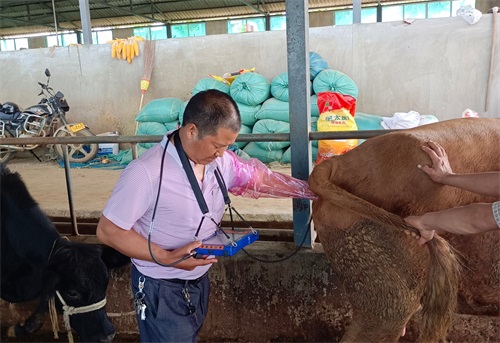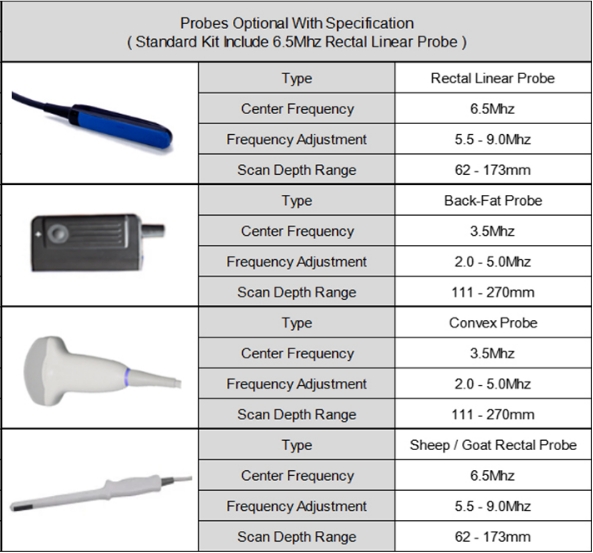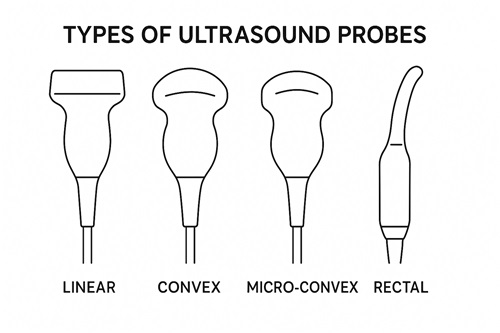When it comes to livestock management, early and accurate diagnosis of animal health is critical. Whether you’re working with cattle, الخنازير, خيول, غنم, or camels, veterinary ultrasound is an essential tool. لكن, the effectiveness of an ultrasound exam depends greatly on the skillful handling of the ultrasound probe. Improper technique can lead to poor image quality, misdiagnosis, and unnecessary stress for both animal and operator.

In this guide, we’ll cover how to properly hold a الموجات فوق الصوتية البيطرية probe for livestock animals, ensuring you get the clearest images and the most accurate results.
1. Understanding the Basics: What is an Ultrasound Probe?
An ultrasound probe, also known as a transducer, is the device that sends and receives sound waves to create images of the inside of an animal’s body. There are different types of probes (linear, convex, micro-convex, and rectal) designed for different applications, مثل pregnancy diagnosis, فحوصات البطن, or musculoskeletal imaging.
Choosing the right probe is crucial. For example:
-
Rectal Linear Probes are ideal for bovine and equine reproductive exams.
-
Convex Probes are commonly used for general abdominal scanning in larger animals like pigs and camels.

2. Proper Hand Position: The Key to a Good Scan
Grip and Stability
Hold the probe firmly but gently in your dominant hand. Wrap your fingers around the body of the probe, with your thumb positioned on top for better control. Your grip should be relaxed enough to allow for fine adjustments but steady enough to prevent shaking.
Wrist Positioning
Keep your wrist neutral. Over-flexing or extending your wrist can lead to operator fatigue, especially during long scanning sessions. A neutral wrist position allows for smoother movements and more consistent pressure against the animal’s skin.
Fingers as Anchors
Use your pinky or ring finger to lightly touch the animal’s body when possible. This acts like a stabilizer, helping you maintain consistent contact even if the animal moves slightly.
3. Adjusting Pressure: Finding the Sweet Spot
Applying the right amount of pressure is critical:
-
Too little pressure results in poor contact and a blurry image.
-
Too much pressure can cause discomfort to the animal and distort the anatomy you are trying to visualize.
A good rule of thumb: apply enough pressure to eliminate air gaps between the probe and the animal’s skin but not so much that it causes the skin to blanch (turn white).
4. Orientation and Movements: Mastering the Scan
Understanding Probe Orientation
Most probes have a small marker (a ridge or light) that indicates the direction the probe is facing. Typically, in veterinary scans:
-
When doing a rectal scan in cattle, the marker points to the animal’s tail (caudal).
-
During abdominal scans, the marker usually points to the animal’s head (cranial).
Movements to Practice
-
Sliding: Moving the probe across the surface to follow structures.
-
Rocking: Tilting the probe back and forth to view structures from different angles.
-
Rotating: Twisting the probe to change the imaging plane.
-
Fanning: Pivoting the probe like a windshield wiper to sweep through tissues.
Each movement needs to be controlled and deliberate. Quick or jerky movements can make it difficult to maintain a good image.
5. Tips for Scanning Different Livestock Animals
Cattle
For pregnancy diagnosis, rectal scanning with a linear probe is standard. Use plenty of ultrasound gel and be patient; deep scanning requires steady, controlled movement.
Pigs
Transabdominal scanning with a convex probe is often done while the sow is standing. Light, steady pressure is best to avoid startling the animal.
Horses
Musculoskeletal scans require very stable probe handling because small tendon tears are subtle and easy to miss.
Sheep and Goats
Due to their smaller size, a micro-convex probe works well. Keep movements gentle to reduce stress on the animal.
Camels
Camel reproductive organs are located deeper, requiring more pressure and patience. A longer rectal probe can be helpful.

VET-ULTRASOUND PROBES
6. Common Mistakes to Avoid
-
Gripping the probe too tightly: This causes hand fatigue and poor fine motor control.
-
Applying uneven pressure: Leads to inconsistent images.
-
Ignoring probe orientation: Results in confusing or misleading images.
-
Moving too quickly: Reduces scan quality and can upset the animal.
7. Final Advice: Practice Makes Perfect
Good probe handling is a skill that improves over time. Practice scanning on healthy animals whenever possible to refine your technique. Don’t rush—taking the time to master probe handling will save you countless hours and headaches in the future.
Remember: the goal of ultrasound scanning is not just to “find something” but to thoroughly and accurately assess the animal’s internal health with minimal stress.